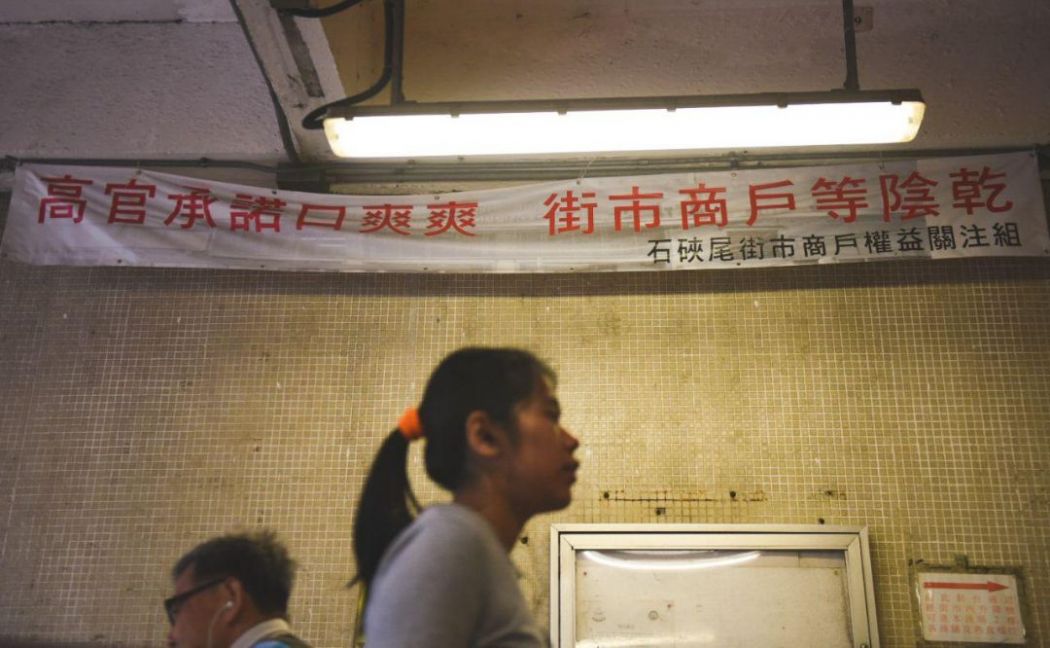In a shop at the Shek Kip Mei market, seamstress Lam Mei-sin makes silk comforters by hand. It takes two hours for the silk floss to be cut, flattened, pulled, and layered; there are now machines for this, but – for her – it remains a craft.
Lam has run Hip Yee Hing Embroidery since 2003. Her father started the business in one of Shek Kip Mei’s resettlement blocks in 1972, and later relocated to the market, where it has stood for almost 40 years.

A one-storey structure that houses more than 360 stalls, the market lies in the shadow of public housing blocks at Shek Kip Mei Estate. In it, the embroidery shop has become something of an establishment: in winter they sold quilts, and in summer, bamboo mats.
But in 2013, Lam found out that she might need to move.
A Housing Department official told her that a new market was in the works and, if vendors agreed to relocate, they may be given priority and receive compensation. The Hong Kong government has been trying to rebuild or renovate dilapidated structures from the post-war era, and Shek Kip Mei market was on the list.
But in the five years since, Lam and other vendors have witnessed a U-turn by the government that has left them frustrated and increasingly desperate.

“They are hanging us out to dry,” Lam said. “They built a new market, but now they leave us behind. So what are we to do?”
Oldest public housing estate
The public housing blocks – ubiquitous in Hong Kong today – began in Shek Kip Mei, in west Kowloon. A 1953 shantytown fire in the district led the colonial government to build resettlement blocks – the earliest incarnation of Hong Kong’s public housing.

The blocks were later replaced by a better-designed model in the 1970s, but after that, Shek Kip Mei Estate would need to wait until the early 2000s for its next renovation.
As the surrounding blocks were rebuilt one by one, the market gradually became outdated, with no air conditioning, poor ventilation, and unhygienic waste disposal. While Lam’s shop was less affected due to the nature of her wares, those who sold fresh food would complain about the heat, she added.

The government announced in 2013 that an adjacent block would receive a face-lift. The “Phase 6” redevelopment is located directly behind the old market, across Shek Kip Mei Street, less than a minute’s walk away.
Construction began in 2014 and was expected to conclude by 2019 and, in addition to the housing units, the site will also include a shopping centre totalling 3,600 square metres – part of which will be reserved for a new market.

Lam said recent years have been a “bad time” for the old market, with dozens of stalls left vacant. So when Housing Department officials approached her to discuss relocation in October 2013, she gave it serious thought.
“The official told me I couldn’t refuse, and the focus of the discussion should be compensation,” she said.
Lam took it upon herself to coordinate among the vendors, but it was difficult to reach a consensus: on the one hand, conditions at Shek Kip Mei market were deteriorating. But the new market would likely entail significantly higher rents, with additional relocation costs.

When Lam got back to the officials months later, she was greeted by an unpleasant surprise – the Housing Department’s relocation plans had somehow vanished.
Flip-flop over relocation
Kalvin Ho Kai-ming, a Sham Shui Po District Councillor, said the vendors were given empty promises.
“When officials told them about relocation, they only gave verbal assurances,” Ho said. “Now a lot of the officials are no longer in the same jobs.”
The government was still intent on building the new market, but its 2018 position was that vendors from the old market would not be given special treatment, and will have to bid for stalls openly.
Ho said that attempts to reopen negotiations have failed: “We tried every possible channel – District Council, Legislative Council, the Chief Executive’s office. The only thing we haven’t done is to occupy the construction site,” he said.
Lam put up a banner across the market’s main entrance, which reads “Say no to two markets, the Housing Department went back on their word.”

It is still unclear what led to the government’s U-turn. Lam speculated that it may be because the Housing Department wanted to avoid paying compensation, or because not enough vendors showed interest.
In a statement, the Housing Department said that only 400 of the 3,600 square metres in the shopping centre will be allocated to the new market, and the old Shek Kip Mei market will remain the primary location for nearby residents to do their grocery shopping.
The Department will also make improvements to the old market, but it will not be a top-to-bottom renovation. Ho dismissed the improvement plan, saying that it only addresses “minor things like the outer walls or toilets.”

With the new market scheduled to open next year, Lam was worried that her fellow vendors would be put out of business. She said she will keep running the embroidery shop: she was raised in Shek Kip Mei and have no plans to leave.
“By this point, my business isn’t the most important. All I want is for us to be treated fairly.”
